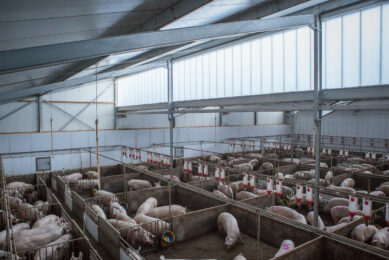EU-funded project: Neonatal mortality in pigs
Farmers suffer an average of 20% mortality per litter of piglets, which represents both a significant animal welfare issue and economic loss to the farmer. On average, neonatal mortality can cost farmers 2.56 piglets per litter twice per year. With current prices a farmer with a herd of 250 sows could lose more than €50,000 per year due to early piglet deaths.
However, research carried out through Welfare Quality® and supported by the Scottish Government, provides practical strategies to help farmers to increase their profits while improving the quality of life for their sows and piglets.
The Importance of Genetics
Traditionally farmers have used farrowing crates to protect piglets against being accidentally crushed by the sow. However, farrowing crates are known to stress the sow and may also be involved in other types of piglet mortality, such as savaging.
There have been vocal public campaigns against the use of the farrowing crate. Hence Welfare Quality® researchers have focused on the genetics of piglet mortality and whether selective breeding can improve the chances of piglet survival in loose-housed or outdoor systems. The research has shown that piglet survival can be improved in just one generation in these non-crate systems.
Researchers found that piglets who find the udder and suckle quickly have better survival rates. This early vitality combined with physical features such as the right body weight and shape all lead to improved survival rates. Piglets that were dead at birth were disproportionately long and thin while surviving piglets were more proportional with a greater fat covering.
Sow characteristics
Sow characteristics are just as important as those of the piglet when it comes to piglet survival. Piglets were more likely to survive if the sow provided them with an efficient placenta that allowed them to develop the right birth weight and shape. Poor placentas increased mortality rates.
As well as selecting for sows that support the development of their piglets, we should also select for sows that show good maternal behaviour. Sows should be calm and quiet during farrowing, and lie down slowly and carefully thereby reducing the risk of accidentally crushing the piglets.
Welfare Quality® researchers studied piglets and sows that were sired from boars with high survival rates versus average survival rates. This study showed survival rates could be substantially improved when breeding from “high survival†boars. Mortality was only 12% in litters selected for high survival compared to 18% in litters selected for average survival. High survival sows were better mothers showing less crushing behaviour during farrowing than average survival sows.
Improving survival using genetic selection strategies benefits both piglet and sow welfare, as well as assisting the farmer by making substantial economic savings. Additionally, this research demonstrates the potential for phasing out of the farrowing crate in the future.
Related Website
• Welfare Quality
Click here for the free Pig Progress newsletter
The Importance of Genetics
Traditionally farmers have used farrowing crates to protect piglets against being accidentally crushed by the sow. However, farrowing crates are known to stress the sow and may also be involved in other types of piglet mortality, such as savaging.
There have been vocal public campaigns against the use of the farrowing crate. Hence Welfare Quality® researchers have focused on the genetics of piglet mortality and whether selective breeding can improve the chances of piglet survival in loose-housed or outdoor systems. The research has shown that piglet survival can be improved in just one generation in these non-crate systems.
Researchers found that piglets who find the udder and suckle quickly have better survival rates. This early vitality combined with physical features such as the right body weight and shape all lead to improved survival rates. Piglets that were dead at birth were disproportionately long and thin while surviving piglets were more proportional with a greater fat covering.
Sow characteristics
Sow characteristics are just as important as those of the piglet when it comes to piglet survival. Piglets were more likely to survive if the sow provided them with an efficient placenta that allowed them to develop the right birth weight and shape. Poor placentas increased mortality rates.
As well as selecting for sows that support the development of their piglets, we should also select for sows that show good maternal behaviour. Sows should be calm and quiet during farrowing, and lie down slowly and carefully thereby reducing the risk of accidentally crushing the piglets.
Welfare Quality® researchers studied piglets and sows that were sired from boars with high survival rates versus average survival rates. This study showed survival rates could be substantially improved when breeding from “high survival†boars. Mortality was only 12% in litters selected for high survival compared to 18% in litters selected for average survival. High survival sows were better mothers showing less crushing behaviour during farrowing than average survival sows.
Improving survival using genetic selection strategies benefits both piglet and sow welfare, as well as assisting the farmer by making substantial economic savings. Additionally, this research demonstrates the potential for phasing out of the farrowing crate in the future.
Related Website
• Welfare Quality
Click here for the free Pig Progress newsletter











